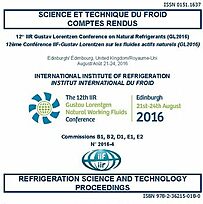
Document IIF
Réfrigérateurs solaires à entraînement direct.
Direct drive solar coolers.
Numéro : pap. 1070
Auteurs : PEDERSEN H., KATIC I.
Résumé
Many people in developing countries are living in areas without electricity from grid. Therefore, obtaining a correct temperature storage of vaccines has been a challenge due to the lack of electricity to maintain the recommended storage temperatures. Currently, most of the vaccines have to be stored at temperatures between +2 °C and +8 °C at the service delivery points. For many years, photovoltaic power has been used for vaccine refrigerators with a lead-acid battery to store electric energy and to provide the start-up current that drives the compressor. The problem with this technology is that the lifetime of the battery is short due to deep discharging of the battery during periods with low sunshine/irradiance. The development of solar “direct drive” refrigerators started in 1999 at Danish Technological Institute (DTI). It was demonstrated that the energy capacity of ice produced by a compressor is at least of the same magnitude as the lead-acid battery. As of to date (February 2016), 24 direct-drive vaccine coolers from eight different manufacturers are listed on the WHO PQS website, with the technology being one of the fastest growing technologies in the vaccine cold chain. This paper endeavours to expound on the current status and discusses how the technology could be used
for other purposes in the future.
Documents disponibles
Format PDF
Pages : 8 p.
Disponible
Prix public
20 €
Prix membre*
Gratuit
* meilleur tarif applicable selon le type d'adhésion (voir le détail des avantages des adhésions individuelles et collectives)
Détails
- Titre original : Direct drive solar coolers.
- Identifiant de la fiche : 30019154
- Langues : Anglais
- Source : 12th IIR Gustav Lorentzen Conference on Natural Refrigerants (GL2016). Proceedings. Édimbourg, United Kingdom, August 21st-24th 2016.
- Date d'édition : 21/08/2016
- DOI : http://dx.doi.org/10.18462/iir.gl.2016.1070
Liens
Voir d'autres communications du même compte rendu (140)
Voir le compte rendu de la conférence
Indexation
-
Thèmes :
Génie pharmaceutique;
Hydrocarbures;
Froid solaire - Mots-clés : Vaccin; R600a; Perspective; Frigorigène naturel; Réfrigérateur; Énergie solaire; Développement
-
Direct drive solar coolers.
- Auteurs : PEDERSEN P. H., KATIC I., JENSEN J. K., et al.
- Date : 24/08/2019
- Langues : Anglais
- Source : Proceedings of the 25th IIR International Congress of Refrigeration: Montréal , Canada, August 24-30, 2019.
- Formats : PDF
Voir la fiche
-
Conception and experimental study of a solar va...
- Auteurs : OUALI M., ABBAD B., BOUABDALLAH A.
- Date : 23/06/2014
- Langues : Anglais
- Source : 3rd IIR International Conference on Sustainability and the Cold Chain. Proceedings: London, UK, June 23-25, 2014
- Formats : PDF
Voir la fiche
-
Extending the autonomy time of an icelined sola...
- Auteurs : JENSEN J. K., BUSK C., CORDING C., et al.
- Date : 24/08/2019
- Langues : Anglais
- Source : Proceedings of the 25th IIR International Congress of Refrigeration: Montréal , Canada, August 24-30, 2019.
- Formats : PDF
Voir la fiche
-
First field test results of a solar thermal off...
- Auteurs : KÜHN R., MÄHNE K., DÜWEL K., et al.
- Date : 24/08/2019
- Langues : Anglais
- Source : Proceedings of the 25th IIR International Congress of Refrigeration: Montréal , Canada, August 24-30, 2019.
- Formats : PDF
Voir la fiche
-
Performance study of a domestic refrigerator de...
- Auteurs : HAMMAD M., EBAID M., MASALHA I.
- Date : 08/03/2015
- Langues : Anglais
- Source : 5th Jordanian IIR International Conference on Refrigeration and Air Conditioning. Proceedings: Aqaba, Jordan, March 8-10, 2015.
- Formats : PDF
Voir la fiche
